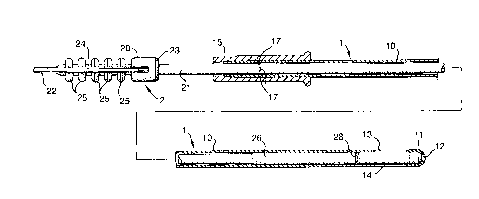Some of the information on this Web page has been provided by external sources. The Government of Canada is not responsible for the accuracy, reliability or currency of the information supplied by external sources. Users wishing to rely upon this information should consult directly with the source of the information. Content provided by external sources is not subject to official languages, privacy and accessibility requirements.
Any discrepancies in the text and image of the Claims and Abstract are due to differing posting times. Text of the Claims and Abstract are posted:
| (12) Patent Application: | (11) CA 2266231 |
|---|---|
| (54) English Title: | GYNAECOLOGICAL SAMPLERS |
| (54) French Title: | APPAREILS DE PRELEVEMENTS GYNECOLOGIQUES |
| Status: | Deemed Abandoned and Beyond the Period of Reinstatement - Pending Response to Notice of Disregarded Communication |
| (51) International Patent Classification (IPC): |
|
|---|---|
| (72) Inventors : |
|
| (73) Owners : |
|
| (71) Applicants : |
|
| (74) Agent: | SMART & BIGGAR LP |
| (74) Associate agent: | |
| (45) Issued: | |
| (22) Filed Date: | 1999-03-19 |
| (41) Open to Public Inspection: | 1999-10-01 |
| Availability of licence: | N/A |
| Dedicated to the Public: | N/A |
| (25) Language of filing: | English |
| Patent Cooperation Treaty (PCT): | No |
|---|
| (30) Application Priority Data: | ||||||
|---|---|---|---|---|---|---|
|
Known endometrial samplers has an outer catheter and an inner plunger slidable
within the catheter. The catheter has a single circular side opening close to
its tip through
which samples are aspirated into the catheter. In the present invention the
catheter has two
two side openings located diametrically opposite one another close to the tip,
the side
openings being elongate along the axis of the catheter. The catheter also has
a coaxial
opening at its tip. The tip of the plunger projects into the tip opening to
form a smooth
surface to the sampler. An O-ring seal on the plunger is located rearwardly of
the side
openings so that suction is applied to both the side openings and the tip
opening when the
plunger is pulled rearwardly.
Note: Claims are shown in the official language in which they were submitted.
Note: Descriptions are shown in the official language in which they were submitted.

2024-08-01:As part of the Next Generation Patents (NGP) transition, the Canadian Patents Database (CPD) now contains a more detailed Event History, which replicates the Event Log of our new back-office solution.
Please note that "Inactive:" events refers to events no longer in use in our new back-office solution.
For a clearer understanding of the status of the application/patent presented on this page, the site Disclaimer , as well as the definitions for Patent , Event History , Maintenance Fee and Payment History should be consulted.
| Description | Date |
|---|---|
| Time Limit for Reversal Expired | 2005-03-21 |
| Application Not Reinstated by Deadline | 2005-03-21 |
| Inactive: Abandon-RFE+Late fee unpaid-Correspondence sent | 2004-03-19 |
| Deemed Abandoned - Failure to Respond to Maintenance Fee Notice | 2004-03-19 |
| Letter Sent | 2001-08-09 |
| Application Published (Open to Public Inspection) | 1999-10-01 |
| Inactive: Cover page published | 1999-09-30 |
| Letter Sent | 1999-06-01 |
| Inactive: Correspondence - Transfer | 1999-05-12 |
| Inactive: First IPC assigned | 1999-05-07 |
| Inactive: IPC assigned | 1999-05-07 |
| Inactive: Courtesy letter - Evidence | 1999-04-27 |
| Application Received - Regular National | 1999-04-22 |
| Filing Requirements Determined Compliant | 1999-04-22 |
| Inactive: Filing certificate - No RFE (English) | 1999-04-22 |
| Inactive: Single transfer | 1999-04-16 |
| Abandonment Date | Reason | Reinstatement Date |
|---|---|---|
| 2004-03-19 |
The last payment was received on 2003-02-26
Note : If the full payment has not been received on or before the date indicated, a further fee may be required which may be one of the following
Please refer to the CIPO Patent Fees web page to see all current fee amounts.
| Fee Type | Anniversary Year | Due Date | Paid Date |
|---|---|---|---|
| Application fee - standard | 1999-03-19 | ||
| Registration of a document | 1999-04-16 | ||
| MF (application, 2nd anniv.) - standard | 02 | 2001-03-19 | 2001-02-09 |
| MF (application, 3rd anniv.) - standard | 03 | 2002-03-19 | 2002-02-15 |
| MF (application, 4th anniv.) - standard | 04 | 2003-03-19 | 2003-02-26 |
Note: Records showing the ownership history in alphabetical order.
| Current Owners on Record |
|---|
| EDWARD PATRICK MORRIS |
| SMITHS GROUP PLC |
| Past Owners on Record |
|---|
| PAUL BENJAMIN RIDOUT |